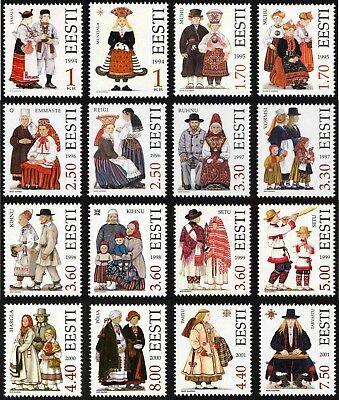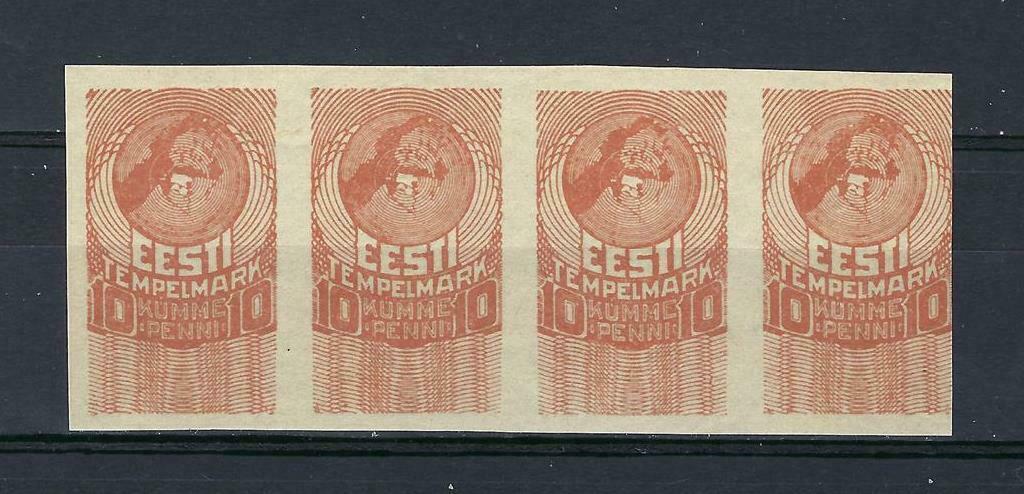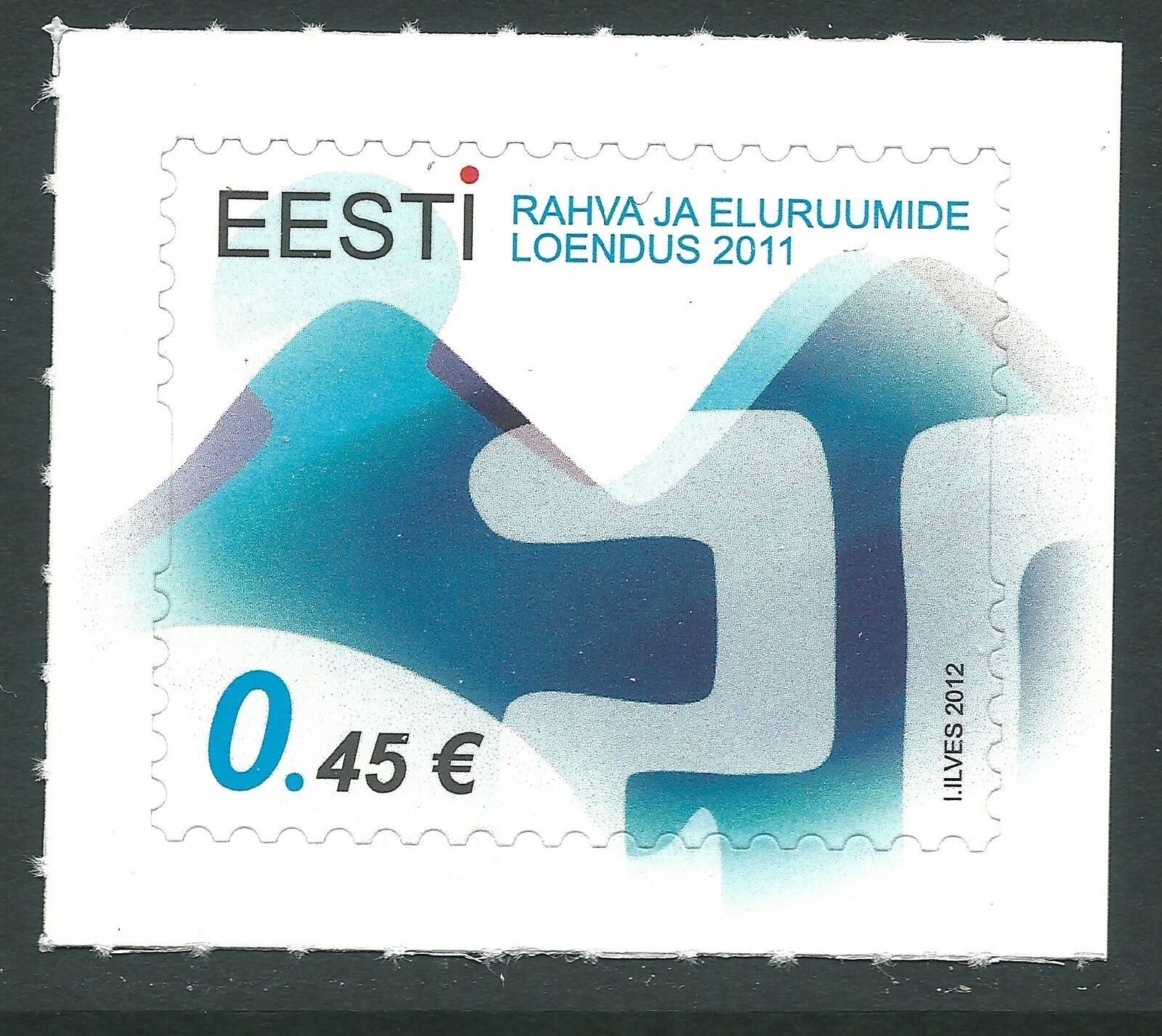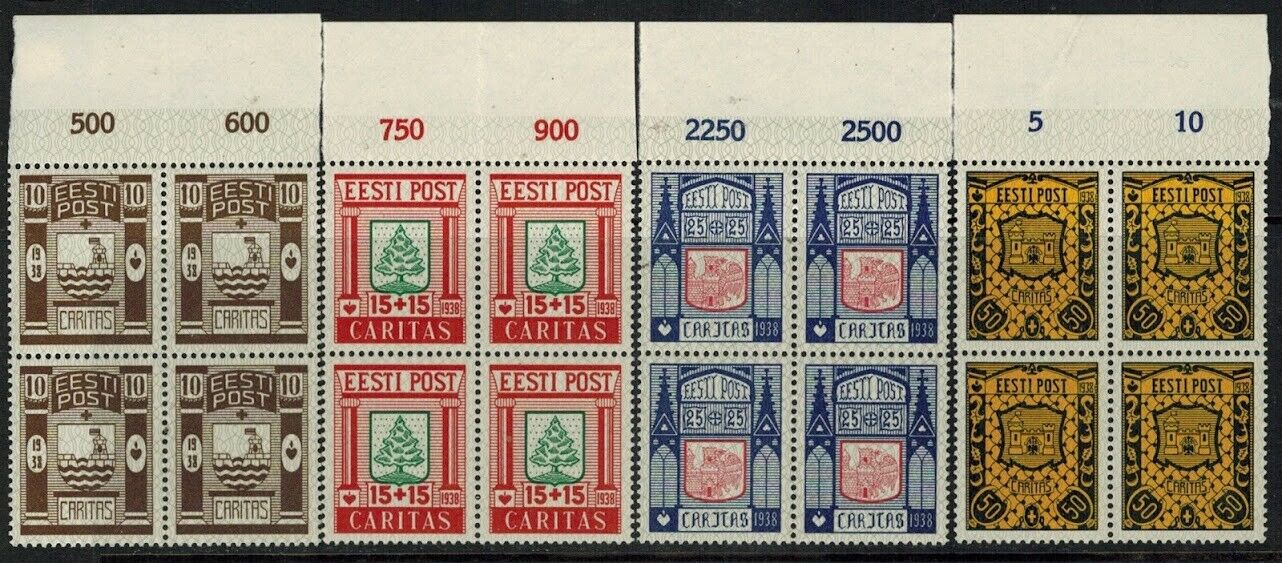-40%
Full stamp SET of ESTONIA - Estonian folk costumes (36 stamps)
$ 22.96
- Description
- Size Guide
Description
FULL STAMP SET OF ESTONIA - Estonian folk costumes on Estonian postage stamps (36 stamps)Shipping and handling:
Registered mail with tracking number - 7.90$
Combined shipping available - NO extra charge for additional stamps/ FDCs
.
Payment: PayPal
.
1995 -
In Estonian folk costumes differ from parish to parish. Besides, there has been considerable change in the course of time. Nowadays, folk costumes are only worn for festive occasions, such as folk dancing, and the song and dance festivals taking place at regular intervals from local to national level. The two stamps picture folk costumes from the West Estonian island of Muhu. The couple wears an older style of dress which persisted up the middle og the 19th century. The head – dress of the woman in the maximum card was only worn big festivities, such as weddings. The two stamps picture folk costumes from the West Estonian island of Muhu The dress of the three girls on the other stamp is more modern, having been in use around the turn of the century. Their headdress was part of everyday apparel. The main element in the design of the envelope is the so – called eye brooch, the most popular Muhu ornament, decorated with glass ’stones’. The main element of the postmark is the so – called Muhu whorl, an ancient symbol of holiness, infinity, perfection and happiness which is also supposed to protect its bearer from evil.
1996 -
Estonian folk costumes as they are today were worn in the 19th, in some places even in the 20th century. Some features of the costumes, however, go back to a very distant past. Today folk costumes are worn by many people to song and folklore festivals, by some woman on other festive occasions. On the islands folk costumes persisted long and possessed a lot of differences as compared with those worn on the mainland. The folk costumes of the islanders of Hiiumaa, settled by people from Saaremaa, the mainland and Sweden early in this millenium, retain features from all those areas. The folk costumes of Reigi in the stamp are from late 19th century. The sitting young married woman wears a high headdress with a festive pleat. The girl beside her is dressed in mourning, with a black pleat and lace sleeves. The latter are of a quite recent origin
1997 -
Thousands of Swedes lived on Estonian islands and coastal areas before World War II. Their resettlement in Sweden in 1943-44 to escape Soviet occupation cut short their traditional centuries-old way of life. Folk costumes not yet influenced by modern trends were worn by the Estonian Swedes on Vormsi and Ruhnu islands up to that time. The stamp depicts Vormsi folk costumes from the middle of the 19th century. Women wore goffered black skirts similar to those worn on other islands, but sewn to a very short bodice covered with short sleeves. Women also wore short black jackets decorated with strips of blue broadcloth and copper buttons, as were men’s jackets. Hair was arranged in arches and braided with yellow and scarlet ribbons. The child’s doll is dressed as a bride. Besides their archaic cut, Vormsi costumes also stand out for their colours: black, white, pure yellow and scarlet. Children’s beautiful yellow dresses were a Vormsi specialty. Men’s clothes were similar to those worn on the neighbouring Hiiumaa Island. Their breeches were of dark woollen or white linen fabric.
1998 -
On Kihnu Island, folk dress in worn daily until today. Older Kihnu folk costumes were in one colour, almost white on festive occasions and grey in daily use, although women's ruffled skirts could also be black ore blue. The striped skirts one can see in Kihnu today are rather a new development. Men's knee-lenght coats are considered to be particulary old. Men also wore seal flipper shoes with upturned toes. Women used red straps to lace up their moccasions and also their skirts were hemmed with red. Their embroidered decorations were mainly in blue and red. Stockings with a wide band of colorful embroidery and figured woollen gloves are still in use today. The Kihnu men's swear (troil) has experienced a revival recently and is quite popular also outside Kihnu. Small children were made patchwork capss of printed cotton. Of the two stamps, the dress of the old couple dates from the middle 19th century and that worn by the family from eearly 20th century.
1999 -
The Setu live next door to Russians. As a result, the dress of the Setu, particularly in more recent times, has some Russian features in addition general Finno-Ugric traits. The outer clothes of both men and women are white. Men wore their shirts over the pants. Besides dark felt hats, also straw hats were worn. Weddings were a particularly long and colourful ceremony, with different, gay outfits worn at its different points. One of the stamps (3.60) features a bride and bridegroom, and the other stamp (5.00) two young men, one blowing a bagpipe and the other a double fife.
2000 -
The Estonian folk costumes series continues with the folk costumes of southeastern Estonia. Sunday clothes of Hargla were in light tones. Women's wore long coats and cardigans bordered with fine red and green cord, while men's coats were bordered with black. The stamp features a family in Hargla Sunday dress.
The Estonian folk costumes series continues with the folk costumes of southeastern Estonia. In Põlva, a black woollen plaid with coloured borders was worn with Sunday dress. Women wore a head ribbon in summer and a hat with a red top in winter. The stamp pictures two women in Põlva Sunday dress.
2001 -
Some extremely old traits and archaic ways of ornamentation survive in Mulk folk costumes. The folk costumes of Paistu and Tarvastu are rather similar. For both men and women, the festive clothing was a long woollen black coat abundatly decorated with bright cord and patches of bright cloth. Fur coats were also very beautiful. The girl on the Paistu stamp wears a splendid fur coat decorated with coloured straps and strips of polecat fur.
2002 -
On the two new postage stamps of the Estonian Folk Costumes series, the Central Estonian people wearing the folk costumes of Suure-Jaani and Kolga-Jaani parishes are depicted. In the middle of the 19th century, new modern folk costumes became popular in the Viljandi parish. In the patterns of shirts, waists, coifs, stockings and mittens old elements can be seen, but suits for men with their tunics, breeches, often with waistcoats, and the tight waist-lined jerseys for women have been modelled after the city fashion. On the postage stamp of Kolga-Jaani folk costumes there is a maiden and a married woman, but on the postage stamp of Suure-Jaani folk costumes a boy and a girl are depicted in the folk costumes of mid-19th century.
2003 -
The next two stamps from the Estonian folk costumes series are devoted to mid-19th century traditional dress from the southern Tartu County, one featuring an Äksi woman and girl and the other an Otepää woman, man and girl. Tartu County was rather receptive to various innovations, so the dominating dress in the mid-19th century was quite modern there. Older features included various shoulder wraps and shawls both for daily and Sunday wear. Girls wore a wreath or a headband.
2004 -
North Estonia, where Viru is the easternmost county, is more or less uniform in terms of traditional dress with no big differences between the individual parishes. The most conspicuous common feature for women was a characteristic short shirt or blouse called käised, sleeves. Complemented with a vertically striped skirt, it constituted the typical north Estonian women’s dress in the 19th century. Longer than elsewhere, Viru wives traditionally wore caps, while girls adorned their heads with chaplets. Besides the cap, a married woman had to wear an apron, and in the 19th century it was often made of fabric bought from a shop. The girdle was wrapped several times round the waist, with brooches, beads and coin necklaces worn for decoration, as far as one could afford them. In addition to the traditional soft cowhide pastlad, shoes were used for footwear, and in a few cases they even had tapering heels. In men’s dress, the most widespread garment in 19th century North Estonia was a blue suit with knee breeches, which should actually be regarded as a folk adaptation of fashion clothes. White or blue and white striped linen clothes were used for summer wear. The main headgear for men was a tall black felt hat. Young man and girl from Viru-Jaagupi in dress of the first half of the 19th century.
2005 -
In terms of its folk costumes the Järva County, along with the counties of Harju and Viru, belongs to a more or less homogeneous North Estonian group. Järva floral embroideries are often of one colour white, blue or black (dark brown), but there are also multicoloured ones. In earlier times a headdress called linuk, with the tail covered with a large-flowered design, was in use in various parts of Estonia, while the skirts were of a single colour, mostly black. The hemline was sometimes decorated with gorgeous wide bead embroidery, sometimes with ribbons and tinsel. In some places they were worn as late as the mid-19th century side by side with newer vertically striped skirts. Järva coats have traditionally been black. The men's short jackets and breeches were mostly blue in the mid-19th century, replaced with blue or striped linen ones in the summer. The man wearing his Sunday best in the Ambla stamp boasts the traditional black Järva long coat, with the woman wearing the ancient linuk headdress and a skirt of the older type, with bead embroidery. The girl's striped skirt was in general use in all Estonia. In the Türi stamp, one of the women in her best clothes has a linuk headdress with flashy multicoloured embroidery, her companion wearing a smaller cloth cap with floral decorations. Floral sleeves were widespread all over northern Estonia.
2011 -
Clothes of more or less the same type as elsewhere in North Estonia were worn in Harju County, although wide differences can be found particularly in the colours and decorations of women’s dress. From Jõelähtme near Tallinn a girl and a woman from the first half or the middle of the 19th century have been reproduced on the stamp. The girl’s headgear is a so-called eared wreath and a wide red band decorates her green-striped skirt. The girl’s sleeve embroidery is rather simple, but the sleeves of the married woman who sports an embroidered apron are decorated with lavish wide embroidery. She wears a pot hat lined with silk. Gradually spreading, such hats crowded out the earlier traditional women’s headgear. The Rapla woman on the other stamp also wears a hat. The so-called eye brooch with red stones was a popular festive decoration. The Rapla woman wears white embroidered sleeves, a skirt with horizontal stripes of a more modern type and a purchased apron with large flowers embroidered on it. The man with the bagpipe wears a grey jacket and light pants with blue stripes. The traditional and quite widespread man’s suit in North Estonia was navy blue.
2012 -
The stamps feature women of Hageri and Nissi Parishes in late 19th century dress. In that period, most Harju County men already wore city clothes. Checkered skirts, as well as dresses and jackets, then made their way into women’s attire. The main headgear throughout North Estonia was the pot hat that came in various colours. Girls’ headdress used to be wreaths and in Hageri they were sometimes made of strips of fabric of different colours. Kerchiefs were frequently worn, sometimes several of them one over the other. The Hageri woman and girl are wearing large purchased woollen kerchiefs, and besides, the woman is wearing a silk kerchief over her pot hat. Married women still observed the tradition of wearing an apron, which could have been of light white fabric, and in case of the Nissi woman it is decorated with embroidered lace and cord rucks. The Nissi woman is wearing a black lamb wool cardigan, although also jackets of novel design were worn at the time, and she has a sleigh rap over her forearm.
2013 -
The stamps feature folk costumes from Kihelkonna in Western Saaremaa and from Karja in the North-eastern part of the island. The Karja stamp shows an elderly couple in long coats, dress worn around the middle of the 19th century as well as later, with red strings and coloured edges adding zing to the dark fabric. The man’s long coat is edged with a wide striped belt in many colours. Mittens were a necessary part of the attire and when there was no need to put them on, they were stuck in the belt. Men and women throughout Saaremaa invariably wore checkered kerchiefs – men round the neck and women on the head. The man carries a tobacco pouch, while the woman’s pouch contains needles. The pouches were made of bits of coloured cloth. The woman wears one of the most peculiar Saaremaa headdresses – a round coloured cap, while the young married woman in the Maxicard wears a bonnet peculiar to the eastern part of the island. In Karja it could be either in geometric or floral design. Saaremaa bonnets all have a similar cut, but are still of a totally different appearance. The Kihelkonna woman featured in the postage stamp is shown in a tasselled bonnet general in Saaremaa, although it is different in the various parts of the island. A conspicuous feature, particularly for its shape, is the black crinkled skirt with a coloured lower rim. As for decorations there was a custom to wear several simple brooches one above the other. The First Day Cover shows how they were actually worn. The First Day postmark has a small motif from the Kihelkonna bonnet.
2014 -
Mihkli Parish lies on the boundary of the Lääne and Pärnu Counties. One of the stamps has a young man and girl in clothes of the mid-19th century. The young man wears a suit typical to the period but differs from others by its greenish blue colour. Also the girl’s cardigan with puffy sleeves is slightly peculiar. The girl is bareheaded, but married women wore a rather peculiar cocked cap which had to be tied under the chin so it would stay in place at all. The embroidery of one such cap has been used in the First Day cancellation. In the second half of the 19th century women of Vigala Parish wore beautiful red chequered skirts, cardigans with the shoulders buffed up and wide necks, later also jackets, tall hats, aprons of print cotton as well as numerous kerchiefs. Necklaces of coin pendants were the preferred jewellery in Vigala Parish; some of them had several rows of beads and pendants. Sometimes we have to do with coin imitations, such as the pendent pictured in the FDC.
2015 -
The fashion of flowery skirts developed at the end of the 19th century. It was triggered by the decoration of carpets with flowery embroidery that was called “roosimine”. The rose embroidery carpets spread also to other places but rose embroidery skirts were only made in Lihula and in the neighbouring parish of Kirbla. At the turn of the 19th and 20th century the Lihula and Kirbla folk costumes were so similar that it was often not possible to identify by their style, and they were often made by the same masters. Earlier striped, checkered and patchwork skirts were knitted, and they were worn simultaneously with flowery ones. One such patchwork skirt is worn by the Lihula girl pictured in the postage stamp. The favourite colour at later times was bright red, but there are also skirts embroidered in darker red and bright blue fabric. Also the number of decorations raises attention and sometimes the whole chest is covered with coins. Married women’s hats had wide lace and with wide and long ribbons. For apron cloth often curtain laces were used. Lihula and Kirbla shirts have very wide cuffs. At the end of the 19th century shirts started to be decorated with red cross-stich embroidery. The shirts of the grooms were particularly sumptuous. The Lääne County men usually wore a rather townish ware; the fashion headgear was a peaked cap. The FDC has a part of the Kirbla woman’s shirts breast flap in cross stitch and the first day cancellation features the motif that is represented on Lihula and Kirbla embroidered skirts.
2016 -
The postage stamps feature Pärnu County folk costumes -- Audru woman and man and Tõstamaa girl and woman in the middle of the 18th century. In Audru both the women’s and men’s dark outdoor clothes were decorated with red strings. The Audru flower decorated caps had a high sharp peak and branchy lace. Also the embroidered collar had a wide lace. The Audru dark blue or black skirts had a peculiar pattern in it. Like in Tõstamaa, various decorative ribbons were sewn to the lower edge of the skirt. A few great fur coats have been found for the museum. They are the most stylish ones in Estonia. Red slantwise strips on the chest are characteristic for Tõstamaa, they can also be found on cardigans. The Tõstamaa long recess coifs have been called tube coifs. Some of them are white, some flowery. The winter cap was edged with fur. Such red caps have been found also from other parts of Estonia. The so-called rosy mittens and stockings are particularly beautiful. The motive of one such pattern has been reproduced on the First Day Cover. Of decorations brooches and necklaces were warn, as well as beads. In Audru, for example, for example it was recommended to wear in line three eye brooches or two brooches and two necklaces. The first day cancellation has a motif from an Audru coif











